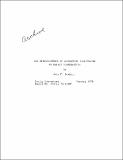| dc.contributor.author | Boshier, John F. | |
| dc.date.accessioned | 2006-03-06T17:47:11Z | |
| dc.date.available | 2006-03-06T17:47:11Z | |
| dc.date.issued | 1978 | |
| dc.identifier.other | 04821757 | |
| dc.identifier.uri | http://hdl.handle.net/1721.1/31288 | |
| dc.description.abstract | Energy policy in the US is characterized by two motivations: to stem the flow of currency to the oil producing nations, and to prevent energy prices rising as much as it is now being feared they will. Conservation has been seized upon as a principal initiative, and the two most important components of present policy are the investment tax credit and energy taxes. The investment tax credit is aimed toward improving the way energy is used without raising the price. It lowers
the price of capital relative to energy for applications where there is a tradeoff. But this measure is working against the current of wider taxation measures which stimulate
energy growth through lowering the price of capital and raising the price of labor, thus encouraging investment in energy intensive equipment to substitute for labor. The
conservation investment tax credit does not reverse this trend. Nor does it have a significant effect in raising the
rate of return on an investment in conservation, which is dominated by the energy savings and the expected inflation
in energy prices. In summary, it appears that the tax credit will have difficulty achieving the goals set for it.
An encouragement of activities that conserve or substitute for energy by promoting employment rather than extra capital
investment is necessary. In a society, which has been built on low cost energy, taxation measures which increase the price of energy are both unpopular and disruptive. But higher prices are inevitable and the rise is likely to be rapid after 1985.
Recession both in the US and throughout the world is very likely. A policy of phasing in higher prices through taxes will enable the economic and social effects to be
monitored and will encourage the necessary new technologies. | en |
| dc.format.extent | 3462583 bytes | |
| dc.format.mimetype | application/pdf | |
| dc.language.iso | en_US | en |
| dc.publisher | MIT Energy Laboratory | en |
| dc.relation.ispartofseries | MIT-EL | en |
| dc.relation.ispartofseries | 78-004WP | en |
| dc.subject | Energy policy |z United States. | en |
| dc.subject | Energy conservation |z United States. | en |
| dc.title | The effectiveness of government initiatives in energy conservation | en |
| dc.type | Working Paper | en |

